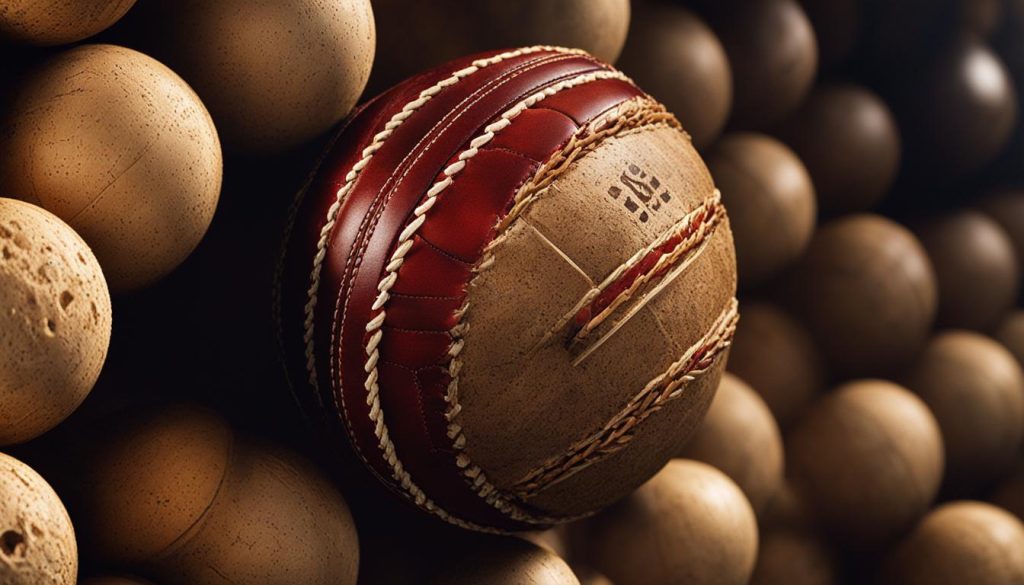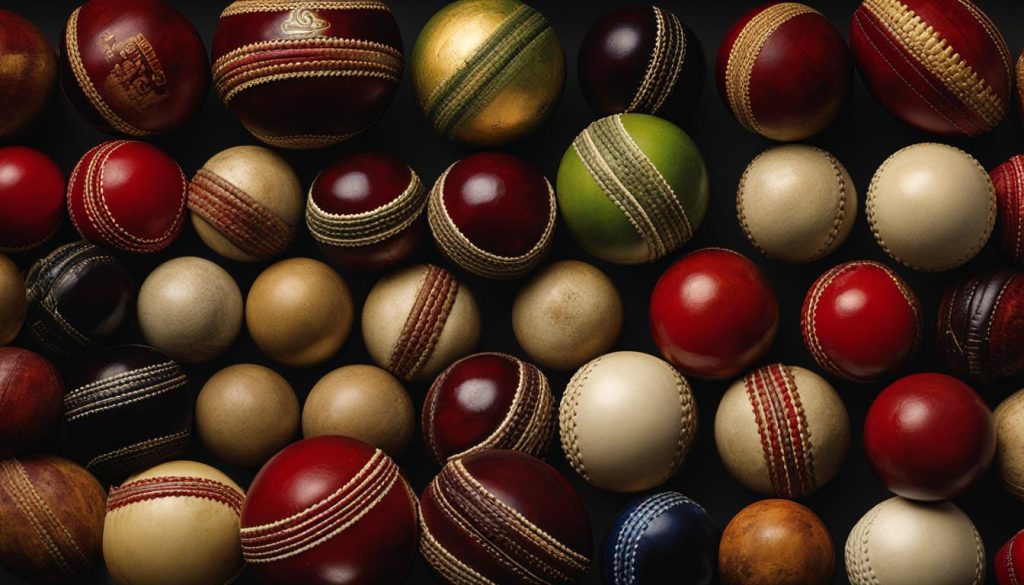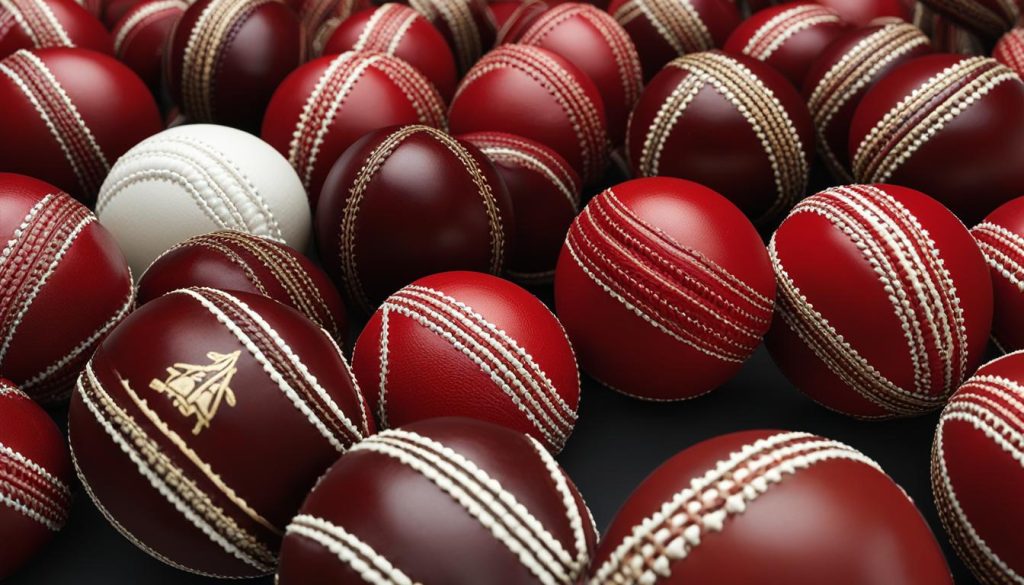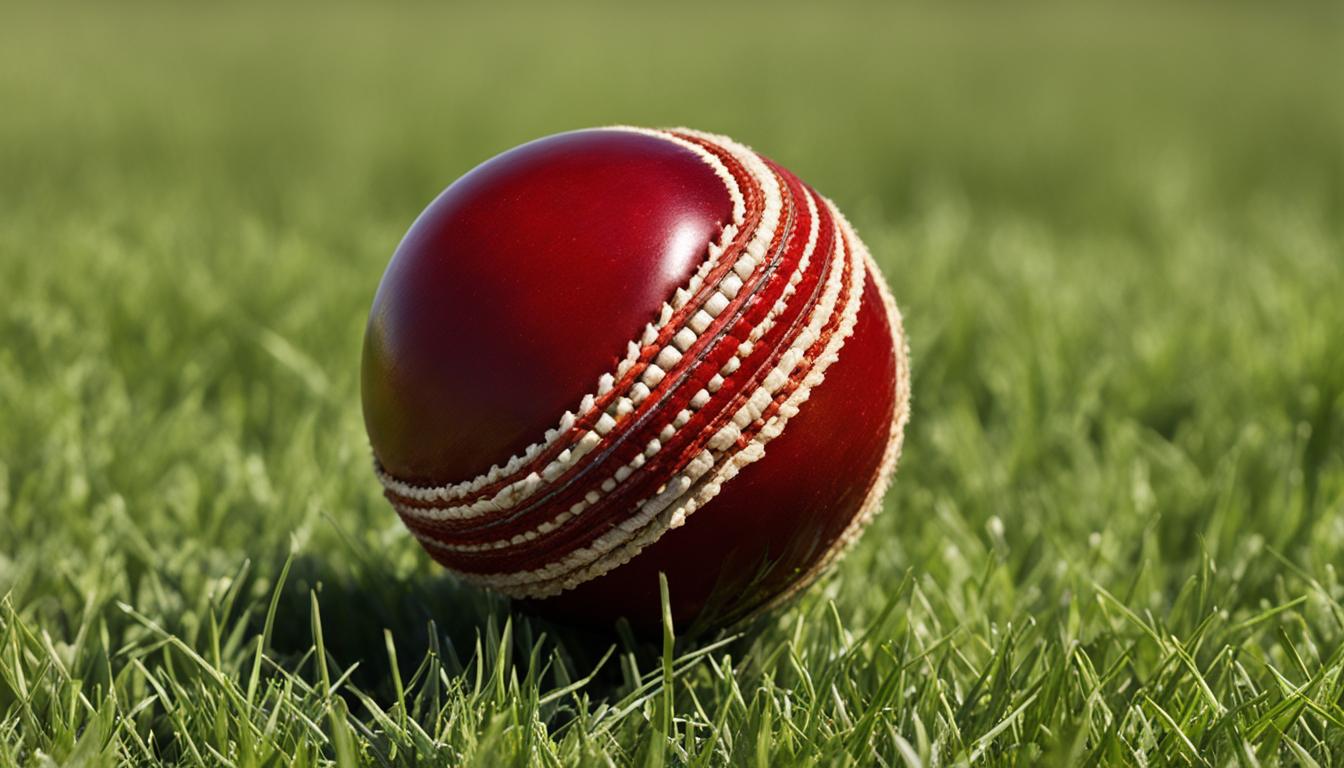As an avid cricket enthusiast, I’ve come to appreciate the nuances that make the game so captivating. One crucial element often overlooked by spectators is the cricket ball weight. With professional matches mandating a weight cricket ball that spans from 155.9 to 163 grams, there’s more than meets the eye. This specific range isn’t arbitrary; it’s the cornerstone ensuring uniformity and fairness in the sport. The weight of a cricket ball isn’t just a number—it’s a decisive factor influencing the ball’s behavior, such as its speed, swing, and bounce, which in turn shapes players’ strategies and the intricacies of cricket dynamics.
Key Takeaways
- The fixed range of cricket ball weight is central to the sport’s integrity and fairness.
- A ball’s weight has a significant impact on its speed, swing, and bounce on the pitch.
- Professional cricket maintains a strict cricket ball weight standard to ensure consistency across matches.
- Understanding the weight cricket ball dynamics offers insight into player strategies and game outcomes.
- The precise measurement of cricket ball weight reflects the sport’s dedication to detail and tradition.
- Standardized weight across different formats ensures a level playing ground in the global arena.
The Role of Cricket Ball Weight in the Sport’s Dynamics
As a devoted enthusiast of cricket, I’ve witnessed firsthand the profound effects the weight of the cricket ball has on the game’s mechanics and player strategies. Due to gravity and momentum, a ball’s weight can drastically alter its trajectory after being pitched, making it a centerpiece of the sport’s rising complexity and excitement. Indeed, physics and regulations converge to shape the crux of cricket’s competitive nature.

The Impact on Speed, Swing, and Bounce
The delicate balance between a cricket ball’s mass and the force applied by the bowler can create a fascinating spectrum of outcomes on the field. A heavier cricket ball tends to plunge swiftly and can command a more pronounced bounce off the pitch, which can be strategically utilized by bowlers to stump the opposition’s batsmen. In contrast, the lighter counterpart could be the weapon of choice for swing bowlers, especially under cloud-cloaked skies, where it can dance unpredictably through the air, eluding the batsman’s precise strikes.
Bowlers and batsmen alike must adapt their tactics to accommodate these physics-driven nuances, each weight fluctuation invoking a different aspect of their skillset. My respect for the intricate skills of these athletes deepens each time I strike this topic, reminding me of the countless hours they put into mastering their response to the cricket ball’s behavior.
Regulations and Standards for Professional Play
Ensuring a level playing field globally, international cricket bodies maintain steadfast regulations to keep the cricket ball within the standard cricket ball weight range of 155.9 to 163 grams. This defined scope guarantees that regardless of the country or climate, every match exudes consistency and fairness.
| Cricket Ball Attribute | Impact on Game Dynamics | Regulated Weight |
|---|---|---|
| Speed off the pitch | Heavier balls facilitate faster speeds | 155.9 – 163 grams |
| Bounce and seam movement | Heavier balls produce more pronounced bounce | |
| Swing | Lighter balls enhance the swing in favorable conditions |
Gone are the days of unpredictability due to non-standardized equipment. Today, every professional cricket match promises a universally fair challenge, a testament to the sport’s dedication to precision and integrity. The enforcement of these weight standards is not only a nod to tradition but a cornerstone of modern cricket’s reverence for maintaining an unbiased competitive spirit.
Red vs. White Cricket Balls: An Examination of Weight Differences
When I delve into the world of cricket, particularly the equipment used, I find the comparison between red and white cricket balls particularly fascinating. While many aspects differentiate these two varieties, their weight cricket ball specifications are surprisingly similar. Both types adhere strictly to the international cricket standards, ranging from 155.9 to 163 grams. However, the red cricket ball and the white cricket ball each provide unique characteristics suited to their specific formats of the game.
Let’s talk about the red cricket ball, a symbol of tradition in the cricketing world, predominantly used in Test matches and first-class cricket. The renown of the red cricket ball comes from its extraordinary durability and its capability to maintain its condition over a prolonged period of play. It supports the classic swing techniques that have been perfected by generations of bowlers. On the other hand, the white cricket ball, known for its high visibility under floodlights, is the ball of choice for limited-overs formats, such as One Day Internationals and Twenty20 matches. Its visibility is not the only attribute; it also exhibits different seam movement, which brings along alternative strategies for batsmen and bowlers alike.
Despite their color and usage in different match types, both balls conform to the required weight cricket ball regulations, ensuring consistency in play across all formats. Let’s review the specifics that not only differentiate the red cricket ball from the white cricket ball but also underscore their similarities.
| Characteristic | Red Cricket Ball | White Cricket Ball |
|---|---|---|
| Weight | 155.9 to 163 grams | 155.9 to 163 grams |
| Usage | Test matches, First-class cricket | Limited-overs formats, Day-night matches |
| Durability | High – Maintains condition over long play | Varies – More frequently replaced |
| Visibility | Favorable in daylight | Enhanced for artificial lighting |
| Swing/Seam Movement | Traditional swing mechanics | Distinct seam movement |
The table clarifies that while the physical weight cricket ball specifications do not diverge, the red cricket ball and the white cricket ball are designed for their respective match conditions, offering dynamic approaches to this illustrious sport. It reiterates the importance and precision in the manufacturing of cricket balls to sustain the essence of competitiveness irrespective of the version of the game being played.
Understanding the Materials: Composition of a Cricket Ball
Delving into the materials that contribute to the weight of the cricket ball and its performance on the field unveils a meticulously engineered design. It is this careful selection and combination of materials that gives the cricket ball its distinctive characteristics, impacting every delivery bowled and every shot played.
Genuine Leather and Its Contribution to Ball Weight
At the outermost, a cricket ball is enveloped in high-quality genuine cowhide leather. This robust material is not only essential for providing the long-lasting durability expected from professional-grade equipment but also contributes significantly to the overall cricket ball composition. The leather’s weight adds heft to the ball, facilitating a firmer grip for the bowlers and better control for the players all around.
The Cork Core’s Influence on Ball Heft
At the core of the cricket ball lies a sphere made from compressed cork, which plays a pivotal role in achieving the substantial feel associated with the sport. This cork center adds density and mass, creating a ball that carries its momentum through the air and rebounds effectively upon hitting the pitch. The combination of the cork’s density with the outer leather ensures the ball strikes the ideal balance between weight and bounce — a defining feature critical to cricket’s unpredictability and charm.

Historical Evolution of the Cricket Ball’s Weight
As I delve into the history of cricket, it becomes clear that the evolution of the cricket ball’s weight has significantly impacted the sport. Examining archival records and materials, we discover how the transformation from rudimentary handcrafted objects to the precisely balanced cricket balls of today has revolutionized the game.
Early Cricket Balls and Their Construction
The origins of cricket date back to the 16th century, where early cricket balls were made from a variety of materials and lacked the consistent weight of modern balls. Often improvised with available materials, these early iterations varied significantly in weight and construction, which affected the game’s consistency and challenge.

Leather and Cork Adoption: A Game Changer
The pivotal turn in cricket ball development came with the introduction of leather and cork during the 18th century. This was a game-changing moment, as it introduced a standard in durability and performance. The leather provided a hard-wearing exterior, while the cork became the core of balance, providing the ideal weight of cricket ball for a competitive edge. The interplay between these materials ensured the ball’s desired performance characteristics, establishing cricket as a game of skillful precision.
- The uniform size and cricket ball weight ensured by leather and cork construction.
- The importance of maintaining stringent standards to preserve cricket’s competitive essence.
- The influence of historical changes on modern cricket ball weight regulations.
Manufacturing Precision: How Cricket Ball Weight is Ensured
The craft of cricket ball manufacturing is both an art and a science, necessitated by a commitment to maintain the standard weight cricket ball crucial for the sport’s integrity. The following stages illustrate meticulous control and adept skills that dictate the resilience and competency of each cricket ball produced.
Quality Control and Consistency in Production
Quality control is the cornerstone in manufacturing cricket balls, as it ensures each ball meets the vital specifications for professional play. The process is quite elaborate and consists of different layers of scrutiny. After a rigorous selection process, where only the superior materials are chosen, techniques including tanning and drying, followed by cutting, and stitching establish the foundation for consistency. To affirm the weight of the cricket balls remains within the international standards, precision instruments gauge every ball, with any outliers immediately reworked or dismissed.
The Role of Craftsmanship in Cricket Ball Creation
Craftsmanship in cricket ball manufacturing cannot be overstated; it’s the human skill and attention to detail that bring together quality cowhide and cork with unparalleled preciseness. Each ball is a testament to the seasoned artisans who, with every fold and stitch, ensure the weight cricket ball stays consistent from seam to seam. The culmination of their work is a spherical masterpiece optimally designed for the cricket pitches worldwide.

Below is an overview of the cricket ball production process ensuring the perfect weight conception:
| Material Selection | Treatment & Preparation | Assembly | Quality Assurance |
|---|---|---|---|
| Premium cowhide & quality cork | Tanning, drying, and cutting | Shaping and stitching | Weight measurement and inspection |
| Conservation of material characteristics | Maintenance of the weight within the 155.9 to 163 grams range | ||
We observe every step of the cricket ball’s journey, from material sourcing to final inspection, which molds an impeccably balanced cricket ball. Such a level of precision ensures not just a ball of correct weight but also one that entrusts players with the quality they need to excel at the highest levels of the game.
Cricket Ball Weight and Its Effect on Playing Conditions
As a passionate observer of cricket, I’ve noticed the weight of the cricket ball is more than just a specification; it dictates the flow and strategy of the game in diverse environments. Contenders of this classic sport must not only master the intricacies of technique but also understand how a ball’s weight intertwines with the elements of the playing field. To encapsulate the effect of the cricket ball’s weight on playing conditions, I present an analysis that elucidates why the cricket ball weight standards are vital for competitive fairness and playability.
The condition of the pitch plays a significant role in how the weight impacts the game. A harder surface compounds the effect of a heavier ball, potentially accelerating its pace and amplifying its bounce, making it a challenge for batsmen. Conversely, on a softer pitch, a ball at the lighter end of the spectrum could provide bowlers the advantage of unpredictable swing, especially if the skies above are overcast, thereby assisting in the art of deception.
Altitude is another interesting angle; at higher elevations, the air is thinner, which might aid a lighter cricket ball to travel faster, thus altering the engagement between bat and ball. This aspect alone showcases the meticulous considerations teams must take when playing in varied topographical conditions.
Indeed, weather is the all-too-familiar fiend and friend in cricket. A heavier ball might fare better in windy conditions, maintaining a consistent trajectory, while a lighter ball could be victim to the whims of the breeze. The weight is therefore pivotal in providing consistency through the uncontrollable elements of nature.
I will continue to watch, with a keen eye, how the weight of the cricket ball shapes the tactics and outcomes of matches, appreciating the regulations that uphold the cricket ball weight standards—the unsung hero in the narrative of this glorious sport.
The Art of Selecting the Right Cricket Ball Weight for Match Day
Imperative to the essence of cricket is the selection of an ideally weighted ball for any given match. As I delve into the intricacies of the sport, I realize that the cricket ball weight plays a pivotal role beyond mere compliance with regulations. It’s an art form that blends meteorology, physics, and sheer player intuition. Groundsmen and team strategists often exhibit a preference for a ball that aligns perfectly with the day’s conditions and tactical objectives, making the weight of a cricket ball a significant factor in match outcomes.
Here is a snapshot of the factors I consider when selecting the right cricket ball weight for match day:
- Pitch Condition: A fresh, green pitch may call for a heavier ball to exploit seam movement, whereas a dry, cracked surface might benefit from a lighter one to maximize spin.
- Weather: Overcast skies are conducive to swing, urging the selection of a ball with just the right heft to navigate the air currents.
- Wear and Tear Expectations: An understanding of how the ball’s condition evolves over the course of play influences my choice, considering the changing dynamics as the ball ages.
Each match presents its unique set of considerations that implore a deep understanding of the game’s subtleties. Whether it’s a fierce international competition or a local club match, the artful selection of a cricket ball, with its varied cricket ball weight, embodies the strategic intricacies that give cricket its revered complexity.
What is the Standard Weight of a Cricket Ball and Does it Differ Depending on the Color?
The standard weight of a red and white ball cricket is between 155.9 and 163 grams. While the color of the ball does not affect the weight, it is an important factor in determining its visibility and performance in different playing conditions.
Conclusion
Throughout this exploration of cricket ball weight, we’ve delved deeply into the vital role that the weight of the cricket ball plays in shaping the essence of the sport. Precision in cricket ball weight is not merely a manufacturing requirement but a celebration of the sport’s commitment to fairness and tradition. Every seam on the leather and bounce from the core is a testament to the years of innovation and regulation—a confluence where science meets spectacle, giving each match its distinct character.
By understanding the balance and specifications that go into crafting each ball, weighing consistently between 155.9 to 163 grams, we gain a greater appreciation for the subtleties that define the game. The interplay of materials, regulations, and conditions together create a complex narrative for each ball, indicative of the sport’s history and evolution. It’s a weighty matter, not just in grams but in its influence on strategy, skill, and the unpredictable outcomes that keep enthusiasts captivated.
In essence, the cricket ball weight is the invisible hand guiding the dance of bowlers, batsmen, and fielders alike. As a cricket aficionado, the insight gathered from this piece makes watching the next game not just an act of fandom, but an intellectual engagement with every pitched ball—forever cognizant of the delicate balance that makes cricket an enduring global passion.
FAQ
What is the official weight range for a cricket ball in professional matches?
The official weight range for a cricket ball in professional matches is from 155.9 to 163 grams.
How does the weight of the cricket ball affect its performance in a game?
The weight of the cricket ball directly influences its speed, swing, and bounce, which are critical for players’ strategies and the overall dynamics of the game.
Are there any weight differences between red and white cricket balls?
No, both red and white cricket balls used in professional cricket matches conform to the standard weight range of 155.9 to 163 grams. The color difference caters to different match formats but does not affect the weight.
What materials are used to make a cricket ball, and how do they contribute to its weight?
A cricket ball is made from genuine cowhide leather for its exterior and a cork core for the interior. The leather provides durability and grip, while the cork contributes to the ball’s weight and bounce.
How has the cricket ball evolved over time in terms of materials and weight?
Initially crafted from various materials, cricket balls evolved significantly after leather and cork were adopted in the 18th century. These materials provided enhanced durability, bounce, and a standard weight, thereby solidifying cricket’s competitive essence.
What is involved in the manufacturing process of a cricket ball to ensure its precise weight?
The manufacturing of a cricket ball involves the selection of premium cowhide and quality cork, followed by steps such as tanning, drying, shaping, and stitching. Stringent quality control ensures the ball’s weight remains within the 155.9 to 163 gram range.
How do different playing conditions affect the performance of a cricket ball?
Playing conditions such as pitch hardness, weather, and altitude can have various effects on the performance of the ball due to its weight. Heavier balls may result in more speed and bounce off a hard pitch, while lighter balls can aid in swing under overcast conditions.
Why is the weight of the cricket ball crucial when selecting a ball for match day?
The weight of the cricket ball is crucial as it plays a significant role in the strategy and execution of play. The correct ball weight can complement a team’s tactical approach and the specific conditions of the pitch on match day.






